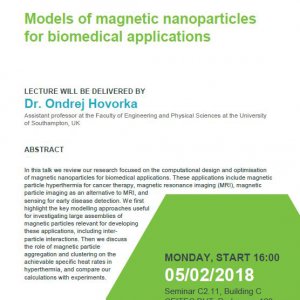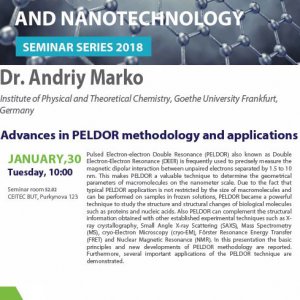
| Phone: |
+420 54949 4003 |
| E-mail: |
,
|
| Office: |
|

| Phone: |
+420 54949 8063 |
| E-mail: |
,
|
| Office: |
|
Research areas
-
Structure, evolution and maintenance of telomeres and their roles in chromosome stability and plant speciation; this includes the characterization of nucleoprotein composition of telomeres and telomerases, biophysical analysis of interactions between telomere components by quantitative methods, analysis of structure-function relationships of telomerase subdomains and analysis of alternative (telomerase independent) strategies of telomere maintenance
-
Epigenetic mechanisms in the regulation of gene expression, chromosome stability and telomere homeostasis
-
Structure, evolution and functions of SMC complexes; the characterization of SMC5-6 complex subunits and MAGE proteins in vitro and in vivo; their roles in DNA repair and chromosome dynamics
Main objectives
-
To investigate epigenetic processes involved in regulation of telomere maintenance
-
To clarify connections between dynamics of telomere composition and DNA damage response
-
To explore evolution of telomeres, telomerase and alternative mechanisms of telomere maintenance
-
To decipher functional links between chromatin (nucleosome) assembly and genome stability
-
To examine interactions and functions of SMC5-6 complex subunits and MAGE proteins
Content of research
Chromatin is a supramolecular complex of DNA, proteins and other associated molecules (e.g. RNA species). It is the building material of chromosomes, which can be observed during cell division in their most condensed state. Chromatin was first discovered in plant cells – as were the cells themselves, or genes.
Since eukaryotic genomes are folded into chromatin, all genome functions occur in the context of this highly dynamic structure. Understanding processes such as DNA replication and repair, transcription or cell differentiation thus requires understanding structure and function of chromatin, and its specific domains like centromeres, telomeres or nucleoli.
While the nucleotide sequence of the DNA component of chromatin constitutes the genetic material of the cell, the other chromatin components (and also modifications of bases in DNA itself) participate in so-called epigenetic functions. These include spatiotemporal regulation of gene activity and DNA replication, correct and precise segregation of genetic material to daughter cells, maintenance of chromosome stability, and protection of genetic material from damage. Importantly, the chromatin structure compacts several metres of genomic DNA to fit the size of a cell nucleus (several microns in diameter) while keeping it functional despite the high degree of compaction (105-106 fold).
Our research group integrates studies in the field of telomere biology, chromatin structure and epigenetics. Using unique features of plant systems (namely their high developmental plasticity), and their comparison to yeast or animal models, we aim to characterise pathways involved in control of chromosome stability and distinguish between specific and general mechanisms involved. Outcomes of our studies (e.g., understanding mechanisms contributing to genome stability, aging or adaptation to changing environmental conditions) can be applied in agriculture, biotechnologies or medicine.
CURRENT RESEARCH INFRASTRUCTURE
The current research infrastructure includes high-end microscopy, quantitative fluorescence spectroscopy, centrifugation and ultracentrifugation, preparative and analytical chromatography, electrophoresis, in situ and Southern hybridization, phosphofluoroimaging, real-time PCR and a documentation system for chemiluminiscence and fluorescence.
1. SMC complexes dynamics
Supervisor: doc. Mgr. Jan Paleček, Dr. rer. nat.
Annotation
The SMC (Structure Maintenance of Chromosome) complexes are the key components of higher-order chromatin fibers and play important roles in genome stability. Three SMC complexes are present in most eukaryotic cells: cohesin (SMC1/3), condensin (SMC2/4) and SMC5/6 complex. Cohesin can make internal loops or embrace two sister chromatids (feature essential for proper chromosome segregation); condensin interconnects loops to condense chromatin during mitosis. The SMC5/6 complex is involved in the homologous recombination-based DNA repair, in replication fork stability and processing, and in cohesin regulation. In our lab, we study assembly and functions of SMC5/6 complexes (http://www.ncbr.muni.cz/SPEC/). New student will use combination of genetic (fission yeast model), biochemical (mostly yeast two-hybrid system and other binding assays) and bioinformatics methods to get deep insights into SMC5/6 features.
Keywords: Structure Maintenance of Chromosome, SMC complexes, SMC5/6; genome stability, chromatin fibers
2. Structure, function and evolution of plant telomere components
Supervisor: prof. RNDr. Jiří Fajkus, CSc.
Annotation
Telomeres are terminal, but nevertheless integral parts of chromosomes, and as such they are also formed and function as supramolecular nucleoprotein (chromatin) structures. Their DNA component is usually formed by repetitive DNA whose incomplete end-replication by the conventional replication machinery can be compensated by elongation via a specific ribonucleoprotein complex with RNA-dependent DNA polymerase activity – the telomerase. Besides preventing the replicative shortening, telomeres also protect chromosome ends from being mistaken for unrepaired chromosome breaks. For the latter function, protein components of telomeres are responsible. Our group has described evolutionary changes in plant telomere DNA repeats and some protein components of plant telomeres in typical telomeres in the model system of Arabidopsis thaliana. It will be important to follow-up these studies with description of further protein components of telomeres together with testing their functional importance for telomere maintenance and chromosome stability. In addition, the impact of the evolutionary change in telomere DNA sequence on its protein interactors will be examined. Background in molecular biology, biochemistry and bioinformatics will be an asset for selection of a suitable candidate. Literature: Fajkus, P., Peska, V., Sitova, Z., Fulneckova, J., Dvorackova, M., Gogela, R., Sykorova, E., Hapala, J. and Fajkus, J. (2016) Allium telomeres unmasked: the unusual telomeric sequence (CTCGGTTATGGG)n is synthesized by telomerase. Plant J, 85, 337-347. Prochazkova Schrumpfova, P., Schorova, S. and Fajkus, J. (2016) Telomere- and Telomerase-Associated Proteins and Their Functions in the Plant Cell. Front Plant Sci, 7, 851. Schrumpfova, P.P., Vychodilova, I., Dvorackova, M., Majerska, J., Dokladal, L., Schorova, S. and Fajkus, J. (2014) Telomere repeat binding proteins are functional components of Arabidopsis telomeres and interact with telomerase. Plant J, 77, 770-781.
Keywords: plant telomere DNA repeats, telomere maintenance, telomerase
3. The role of cytokinins in determination of organ identity.
Supervisor: Mgr. Markéta Pernisová, Ph.D.
Consultants: prof. RNDr. Jiří Fajkus, CSc., Helene Robert Boisivon, Ph.D.
Annotation
Plants, in comparison to animals, are unique in a developmental plasticity that allows their adaptation to changing environmental conditions. Plants undergo postembryonic de novo organogenesis and can continually regenerate organs. This ability is a critically important developmental adaptation in plants. The phytohormones auxin and cytokinin are thought to be major regulators of plant organogenesis. Auxin is necessary to induce de novo organ development, while cytokinins modulate the organogenic response resulting in root or shoot formation. Although the function of several members of cytokinin signalling pathway has already been described, their role in the determination of organ identity is still elusive. The goal of the project will be i) to analyse cytokinin effect in de novo organogenesis and ii) to identify and analyse regulatory factors important for that process. We expect: creativity, self-reliance, willingness to learn new approaches. We offer: experimental work on the project, excellent lab equipment, high-end confocal microscopes, help with both intellectual and practical issues, friendly lab staff, attractive environment of university campus, competitive salary corresponding to the work efficiency.
Keywords: cytokinin signalling, plant organogenesis, organ identity











